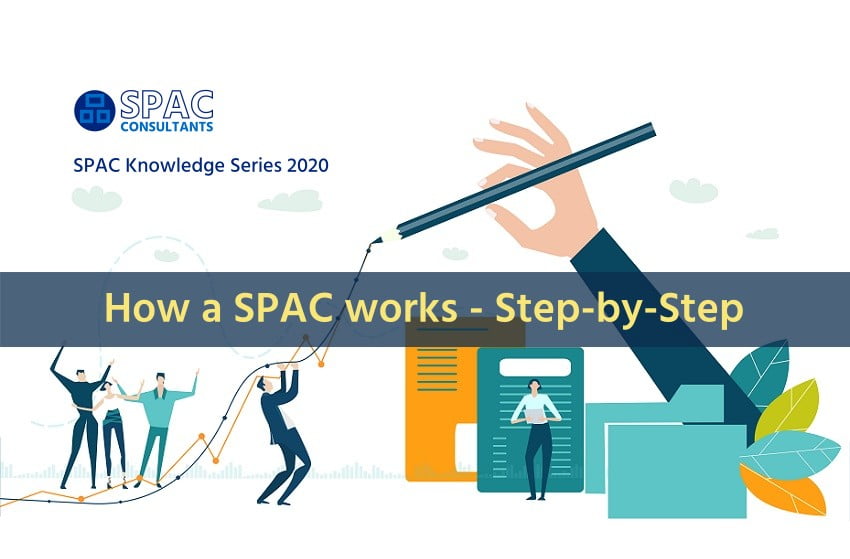SPACs Step-by-Step – from the Idea to IPO to Acquisitions
From the initial idea to sponsoring, structuring, public listing, IPO and acquisition
How does it work?
SPACs Step-by-Step – from the Idea to IPO to Acquisitions
SPACs are Special Purpose Acquisition Companies that are created to raise capital through an IPO to acquire shares of private companies, taking them public through a merger. Despite various structuring alternatives, the general steps from the SPAC idea to its IPO and later acquisition are basically the same.
Please read further to understand how a SPAC is formed, raises capital and acquires a private company, the latter also referred to as “de-SPACing” or “business combination”.

Together with our clients, we discuss the initial SPAC idea and advise for the fine-tuning, including a well-defined acquisition strategy. Once the goal is clear, the basic steps to setup a SPAC and to float its IPO are typically as following:
Step 1: The client, being the SPAC initiator or originator, typically being the SPAC sponsor as well, pays for the first part of the third party setup costs and commits to the necessary sponsor capital, also called skin-in-the-game.
The necessary sponsor capital is generally in the range of 7.0 to 7.5% of the planned IPO size, but may vary in accordance with each SPAC.
The third-party costs to set up a SPAC range around USD 550,000 to 900,000, depending on what is included in this calculation. The setup costs are to be paid by the client prior to the IPO. Setup costs paid may be repaid to the client, subject to client’s discretion.
Step 2: If not done already, the SPAC board needs to be set up. A SPAC management team needs to be set up, which typically comprises a CEO and a CFO as well as 3 independent directors. Often, SPACs opt for a Chairman as well.
The composition of the SPAC board plays an extremely important role in regard of the attractiveness of a SPAC for potential institutional IPO investors. Please read more about the importance of a SPAC management team on our page SPACs – THE RIGHT BOARD.
Step 3: The SPAC is registered as a company, typically in Delaware. Alternatively, clients may prefer the BVI, Cayman Islands, depending on their own tax situation.
Step 4: Auditors, legal counsel and investment bank are appointed, and the SPAC prospectus is drafted. The company applies to the Securities and Exchange Commission (SEC) in the US for the approval and publishing of the prospectus, referred to as S1.
The S1 includes information about the SPAC’s shareholders, board members, size of IPO, cost structure and its acquisition strategy, as well as statutory information.
At this point, the SPAC sponsors provide their sponsor capital, paid on a temporary trust account, being ready for the day of IPO.
Step 5: After the approval of the SPAC prospectus by SEC, the way is paved to approach the right prospective institutional IPO investors during a roadshow. The CEO and the Chairman (if any) of the SPAC and a high-rank member of the underwriting bank are meeting envisaged institutional IPO investors.
This will result in commitments in the order book. Sometimes, it might be a beneficial move to attract (pre-IPO) key investors.
Step 6: The SPAC will be listed on the NYSE or NASDAQ (or other stock exchanges; double listing is also possible) by the underwriting bank. It is now a publicly traded company.
Step 7: On the same day or the day after, the SPAC floats its IPO. Institutional investors provide their fund and receive one unit for each $10 invested in return. One unit comprises one share and one warrant, to be exercised after a successful acquisition. Shares will trade publicly, although there will be little trade volume until first news of possible acquisition targets and respective negotiation is communicated publicly.
SPAC shares are generally offered at USD 10, as common market practice, but may be priced differently.
Step 8: Simultaneously, the SPAC sponsor capital on the temporary trust account is added to the IPO proceeds through a private placement. In return SPAC sponsors receive units, which comprise one share and one warrant for each $10 sponsor capital placed.
In addition to the units, SPAC sponsors are also provided with pre-IPO SPAC founder shares, which get listed on the day of IPO as well.
While SPAC sponsors typically are vested with 20% of the pre-IPO SPAC founder shares as a common market standard, we are generally structuring our SPACs in a way that provides the sponsors with a remarkably larger portion of pre-IPO founder shares.
Step 9: Typically, two or three days after IPO, IPO proceeds are credited to the SPAC’s trust account, where they are blocked until acquisition.
Step 10: The SPAC management team now screens the market for possible acquisition targets, pursuant to the SPAC’s acquisition strategy as defined in the SPAC prospectus. This step includes proper due diligence and audit of any serious acquisition target company as well as negotiations with the shareholder of the company focused on for acquisition.
SPACs can only acquire privately held companies.
Step 11: During the negotiations with the selling shareholders, the SPAC management team has three options to pay for the shares to be acquired. Any combination of those three options is possible as well.
- A share swap where freshly issued SPAC shares are exchanged against the shares of the company to be acquired;
- Cash payment to the shareholders of the private company, to be paid from the IPO proceeds on trust account;
- Asset-backed financing (debt financing where banks lend funds based on the collateral offered by the target company).
The ideal acquisition would be based on the first option above, because in that case, the IPO-proceeds on trust account could be provided to the company as operation capital, after conclusion of merger. This would also create the best upside momentum for the shareholders.
Step 12: Once the SPAC management team and the shareholders of the acquisition target company have agreed on the conditions of the acquisition and the merger of the target company into the SPAC, the SPAC shareholders (IPO investors) need to approve the envisaged acquisition.
Step 13: After the shareholders’ approval, the acquisition takes place and the acquired company will be merged into the SPAC, thus becoming a listed company.
This process is called “business combination”. It is also called “de-SPACing”, as the Special Purpose Acquisition Company is not a SPAC anymore.
Typically, the ex SPAC takes the name of the acquired company.
Making the Most out of Great Assets
SPACs can generate incredible gains for investors, for SPAC sponsors as well as for institutional IPO investors.
SPACs are the new IPO, helping great private companies to access funding from public markets.
We at SPAC Consultants provide substantial added value to SPAC projects that you will not get from most others in the SPAC space.
With our extensive network and resilient connections across the investment industry, we make sure that your SPAC will indeed be successful.
At times where getting funded is an increasing challenge, SPACs offer a great alternative for companies to go public, and for investors to generate extraordinary gains.
Brief SPAC introduction of SPACs
“What is a SPAC? What are the advantages of SPACs? What do we do and why people prefer us!
Our SPACs currently in the making,
available for Sponsor interest:
ASGARD SPAC – Space Technology
HAIMA BIOTECH SPAC:
The HEIDI SPAC: Smart Energy, Blockchain & AI:
Important note:
SPAC Consultants is not offering and/or providing investment advisory services in the sense of regulated investment advisory services as per respective EU Directives and their implementation into national law of EU Member States. Instead, SPAC Consultants offers SPAC Project Management services and consults regarding the general principles of US SPACs and their business structuring. Any investment, legal and financial advice that may become necessary for possible sponsors and investors at advanced stages will be provided by the network partners of SPAC Consultants.




